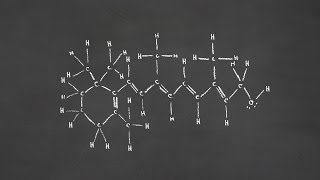(单词翻译:单击)
What is the shape of a molecule?
分子是什么形状?
Well, a molecule is mostly empty space.
分子内部大部分都是空的。
Almost all of its mass is concentrated in the extremely dense nuclei of its atoms.
几乎所有的质量都集中在原子极其致密的核上。
And its electrons, which determine how the atoms are bonded to each other,
而它的电子,则决定原子之间如何相互结合,
are more like clouds of negative charge than individual, discrete particles.
它们比较像带负电荷的云,而不是一颗颗单独的粒子。
So, a molecule doesn't have a shape in the same way that, for example, a statue has a shape.
因此,分子并不像雕塑一样有着特定的形状。
But for every molecule, there's at least one way to arrange the nuclei and electrons
但是对于每一个分子,至少存在一种方式排列原子核和电子,
so as to maximize the attraction of opposite charges and minimize the repulsion of like charges.
使得相异电荷之间的吸引力最大化,相同电荷之间的排斥力最小化。
Now, let's assume that the only electrons that matter to a molecule's shape are the outermost ones from each participating atom.
现在我们假设唯一与分子形状有关的电子是每个原子最外层上的电子。
And let's also assume that the electron clouds in between atoms,
同时我们也假设在原子之间的电子云,
in other words, a molecule's bonds, are shaped kind of like sausages.
也就是分子键,形状像一根香肠。
Remember that nuclei are positively charged and electrons are negatively charged,
记住原子核是带有正电荷的,而电子是带负电的,
and if all of a molecule's nuclei were bunched up together or all of its electrons were bunched up together,
而且如果所有分子的核都堆积到了一起,或者它所有的电子都堆积到了一起,
they would just repel each other and fly apart, and that doesn't help anyone.
它们会相互排斥并且飞散,那就没什么用了。
In 1776, Alessandro Volta, decades before he would eventually invent batteries, discovered methane.
1776年,亚历山德罗·伏打在他发明电池数十年前发现了甲烷。
Now, the chemical formula of methane is CH4.
甲烷的化学式是CH4。
And this formula tells us that every molecule of methane is made up of one carbon and four hydrogen atoms,
这个化学式告诉我们,每个甲烷分子都是由一个碳原子和四个氢原子构成的,
but it doesn't tell us what's bonded to what or how they atoms are arranged in 3D space.
但是它并没有告诉我们哪个原子与哪个原子连在一起,或者在三维空间中这些原子是如何排列的。
From their electron configurations, we know that carbon can bond with up to four other atoms
从它们的电子排布中我们知道,碳原子能与其他四个原子相连,
and that each hydrogen can only bond with one other atom.
而且每个氢原子只能与一个原子相连。
So, we can guess that the carbon should be the central atom bonded to all the hydrogens.
因此我们能够猜测碳原子应该是中心原子,与所有的氢原子相连。

Now, each bond represents the sharing of two electrons and we draw each shared pair of electrons as a line.
现在,每个键代表共用两个电子,我们用一条线表示一对共用电子。
So, now we have a flat representation of this molecule, but how would it look in three dimensions?
于是,我们现在得到了这个原子的平面示意图,但是在三维空间中它看起来是什么样的?
We can reasonably say that because each of these bonds is a region of negative electric charge
我们能够合理地说,因为每个键都是一个带负电的区域,
and like charges repel each other, the most favorable configuration of atoms would maximize the distance between bonds.
同性互斥,最可能的原子构型应该使得键与键之间的距离最大。
And to get all the bonds as far away from each other as possible, the optimal shape is this. This is called a tetrahedron.
而要使得所有的键之间的距离尽可能地远,最合适的形状是这样子的。这叫做四面体。
Now, depending on the different atoms involved, you can actually get lots of different shapes.
根据不同的原子,你可以得到很多种不同的形状。
Ammonia, or NH3, is shaped like a pyramid. Carbon dioxide, or CO2, is a straight line.
氨,NH3,是金字塔形。二氧化碳,CO2,是直线形。
Water, H2O, is bent like your elbow would be bent.
水,H2O,像弯折的手臂。
And chlorine trifluoride, or ClF3, is shaped like the letter T.
而三氟化氯,ClF3,形状像字母T。
Remember that what we've been doing here is expanding on our model of atoms and electrons to build up to 3D shapes.
记住,我们现在做的是根据我们的原子和电子模型建立分子的三维形状。
We'd have to do experiments to figure out if these molecules actually do have the shapes we predict.
我们必须通过做实验来确认这些分子的形状是否和我们预测的一样。
Spoiler alert: most of the do, but some of them don't.
剧透一下:很多是符合的,但是也有一些与预测不符。
Now, shapes get more complicated as you increase the number of atoms.
因为随着原子数目的增加,分子的形状变得越来越复杂。
All the examples we just talked about had one obviously central atom,
我们前面提到的所有例子只有一个明显的中心原子,
but most molecules, from relatively small pharmaceuticals all the way up to long polymers like DNA or proteins, don't.
但是大部分的分子并没有,小到药物小分子,大到很长的多聚体,比如DNA,都没有中心原子。
The key thing to remember is that bonded atoms will arrange themselves
最关键的是参与连结的原子会自动排列,
to maximize the attraction between opposite charges and minimize the repulsion between like charges.
使得异种电荷之间的吸引力达到最大,同种电荷之间的排斥力达到最小。
Some molecules even have two or more stable arrangements of atoms,
有些分子甚至有两种或者更多的稳定的原子排列方式,
and we can actually get really cool chemistry from the switches between those configurations,
在不同的构型之间转换,我们会看到化学是多么酷炫,
even when the composition of that molecule, that's to say the number and identity of its atoms, has not changed at all.
即使分子的构成,即其中原子的数量和种类根本没有改变。


